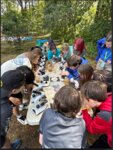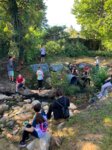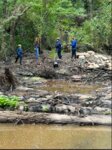 Severna Park
Severna ParkFair, 65°
Wind: 9.2 mph, S
 Severna Park
Severna Park



Sixth-graders from Severna Park, Severn River and Magothy River middle schools got to envision a future as scientists, engineers and environmental stewards during a hands-on project this fall.
Before students got involved, the Anne Arundel County Department of Public Works’ Bureau of Watershed Protection and Restoration did summer construction near Mill Creek in Arnold as part of a capital project to help the county meet some of its clean water goals.
“The area where we went had existing erosion as a result of water coming off the area near Anne Arundel Community College and the schools there, rippling down the channel into Mill Creek,” said Erik Michelsen, deputy director of the Bureau of Watershed Protection and Restoration.
“With the construction, we erected a sand and woodchip bed down the mouth of the eroded channel with stone-grade structures,” he said, noting that a series of wetland pools will now capture sediment.
Once the bureau finished construction, it informed the Anne Arundel County Public Schools (AACPS) Environmental Literacy and Outdoor Education Office.
Through the office’s Chesapeake Connections program, sixth-graders across the county learn about the environment. With two of the middle schools located close to the site, they were a natural fit for a one-month project involving the planting of trees and shrubs, water-quality testing, and other activities.
The site had good access, safe spaces for instruction and restoration work, and the opportunity for students to engage in the local environment, according to Eóin O’Neill, a program specialist with the AACPS Environmental Literacy and Outdoor Education Office’s Chesapeake Connections program.
Prior to their field experience, students engaged in a virtual lesson to learn about stormwater runoff and erosion.
“We also place a lot of emphasis on climate change and how such stormwater projects play a role in adaptation and resilience,” O’Neill said. “While stormwater runoff is a longstanding issue, climate change increases the frequency and intensity of heavy rainfall and exacerbates the issues of runoff, sediment pollution, and nutrient pollution.”
Students planted about 1,100 native trees and shrubs, including several species of oak, beech, birch, sycamore, holly, spicebush and others.
“The field trip was really fun because we planted trees, observed creeks in our area, and looked at water from the creeks under a microscope,” said Severna Park Middle School sixth-grader Shane Tomassi. “My favorite part was planting the trees. It was so much fun.”
O’Neill explained that tree planting and water-quality measuring techniques were just a few facets of the experience, which served to further the connections between the AACPS curriculum and the outdoors.
“Students develop analytical skills as they make qualitative and quantitative assessments to answer questions such as, ‘Is this aquatic ecosystem healthy?’ and ‘What does a healthy aquatic ecosystem look like?’” he said. “Students use scientific methods and principles learned in the classroom and apply them to this real-world experience as they take measurements such as dissolved oxygen levels, nutrient loads and turbidity.”
Severna Park Middle School teacher Carolyn Chew and her classes have participated in Chesapeake Connections since 2014. She and fellow science teachers Alice Fenn and Lidia Futey-Murphy oversaw about 500 students from their school.
“Severna Park Middle School has always done submerged aquatic vegetation (SAVs) or planted trees,” she said, noting that other county schools engage in different projects. “One year, we went to Olde Severna Park’s Hatton Memorial Beach and planted SAVs and got in the water.”
Other schools participate in water-quality monitoring and exploration at state and county parks, tree plantings with private partners, and through oyster restoration experience offered by Annapolis Maritime Museum.
Chew said her students participated in a spring project last school year whereas this year’s unit occurred in the fall. Either way, the lessons benefit the kids.
“They learn about the Chesapeake Bay in the third quarter,” Chew said. “In unit one, they learn about environmental literacy goals.
“They will name the tree they plant,” she said. “It makes them feel good about themselves.”
Through the Chesapeake Connections program, sixth-graders satisfy a 10-hour service learning requirement.
Michelsen thanked the school system for supporting the partnership, despite construction sometimes being disruptive. He sees the collaboration as a way for students to become environmental stewards and to see what projects their parents, the taxpayers, are funding.
O’Niell agreed that the projects encourage students to take pride and ownership through the tangible act of planting a tree.
Chesapeake Connections is one of four main programs run by the Environmental Literacy and Outdoor Education Office, which has a headquarters located at Arlington Echo Outdoor Education Center in Millersville. Other outdoor education office programs include the Trees are Terrific program for kindergarten students held at Downs Park in Pasadena, the Arlington Echo fourth-grade program, and the Water Ready with Drownproofing program for fifth-grade students.
“If students have positive experiences in the outdoors, they may feel more closely connected to the natural environment and develop a sense of environmental stewardship,” he said. “Our other activities also focus on introducing students to real-world skills and possible career paths such as water-quality testing or assessing the biodiversity of an aquatic habitat.”
Comments
No comments on this item Please log in to comment by clicking here